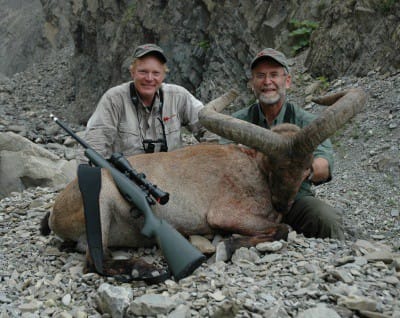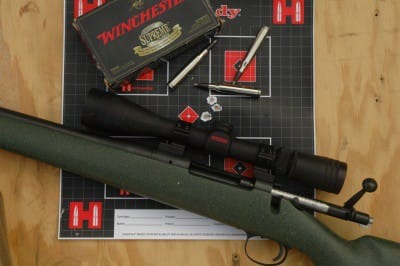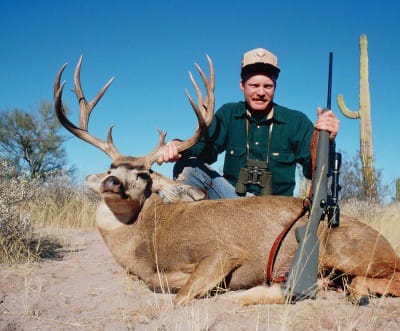
As standard cartridges go, the .280 Remington has one of the oddest histories. Based on the .30-06 case necked down to take a 7mm, or .284-inch bullet, the cartridge was introduced in 1957. It has never had enough sales to support an extensive variety of factory loads, yet those who use it generally swear by it. It is thus almost a cult cartridge, supported by a relatively small group who worship at its shrine. Among them have been some of America’s most astute riflemen. It is the favorite hunting cartridge of Jim Carmichel, longtime Shooting Editor at Outdoor Life, used for an amazing variety of game. Steve Hornady of Hornady Manufacturing has used it to take the majority of the mountain game he loves to hunt.
Both, along with so many other .280 fans, will tell you that it is the best cartridge we have based on the .30-06 case. They will also tell you that with good handloads the .280 will come within spitting distance of the 7mm Remington Magnum, in a shorter barrel, while burning a lot less powder. These things are correct, and yet the cartridge has never been especially popular.
Its beginnings provide a partial answer. It is based on just one of several “7mm-06” wildcats, others including the .280 Ackley Improved and 7mm JRS. These last two remove the body taper, thus increasing powder capacity, and they are indeed every bit as fast as the 7mm Remington Magnum. The .280 Remington retains the gradual taper and gentle shoulder of the .30-06, and even with the best loads will lag a bit behind the 7mm Remington Magnum. However, it was introduced in a different time, when the ascendancy of the bolt action wasn’t as clear as it is today.

So although this seems very odd, Remington actually introduced the .280 Remington in their Model 740 semiautomatic, following with the Model 760 slide-action in this chambering. In order to ensure reliable functioning they needed to keep the pressure down, so for quite a few years factory loads were purposefully mild and didn’t reflect the cartridge’s full potential.
Although it was quickly adapted to bolt action rifles (first Remington’s Model 721, then others), savvy riflemen understood from the beginning that it was primarily a handloader’s cartridge. This was fixed many years ago. Current factory loads aren’t any hotter than any other American factory loads, but they are pretty darned impressive. Standard loads today include a 140-grain bullet at 3050 fps, 150-grain bullet at 2890 fps, and 165-grain bullet at 2820 fps. Handloaders can do a bit better, but today’s factory loads are fast enough and powerful enough to do anything that needs to be done with this cartridge.
Realistically, the damage was probably already done. The .280 Remington shoots about as flat as the .270 Winchester. It shoots flatter than the .30-06, so is probably an ideal compromise between the two, at least on game up to elk in size. Yet it has never been and probably never will be anywhere close to as popular as either… nor is it anywhere near as popular as the 7mm Remington Magnum. Although Remington had the best intentions, efforts to renew interest in this cartridge may well have backfired. At one point there was a move to rename it the 7mm-06 Remington, with hotter loads. This project was cancelled at the last minute, but there are a handful of rifles out there with a 7mm-06 roll mark.
In 1979 they did rename it to 7mm Express Remington, with both rifles and ammo on the market for a brief period. The 7mm Express Remington was nothing more, and nothing less, than the .280 Remington with updated factory loads. Despite initial hype sales weren’t fantastic, and some consumers got confused. There were a few instances of 7mm Express Remington (.280) cartridges being fired in 7mm Remington Magnum chambers. Yes, I know, it sounds silly, but it happened. I actually saw one blowup from this little mistake. The unsupported case head ruptured and ruined the gun. The rifle was a Colt-Sauer, and it vented the hot gases down and out, with no injury to the shooter-but it was a sobering experience.
In 1980 the designation went back to .280 Remington, and it keeps rolling along, never a superstar but always a solid performer. Today there are more and better factory loads to choose from, although nothing close to the selection available in more popular cartridges.
I will admit that I have never been a huge fan of this cartridge. I fully understand and accept its superb capabilities. However, I love the .270 Winchester for its flat-shooting capabilities in open country…and I love the .30-06 for its heavier bullets and tremendous versatility.

Realistically, one could split the difference and choose a .280 and have the best of most worlds-but it’s pretty difficult to love the .270, the .30-06, and the .280! So I don’t. But I have used the cartridge a fair amount over the years. Just by luck of the draw I’ve mostly used it for deer, both whitetail and mule deer, and it’s a great deer cartridge. Like Steve Hornady and Jim Carmichel, I’ve taken it sheep hunting, and it’s well-suited to that role as well. I have never hunted elk with the .280, but I surely would, especially with 160 or 165-grain bullets.
Almost needless to say, the cartridge has never let me down. Although it remains at its best as a cartridge for handloaders, today’s array of factory loads, though limited, are adequate for every purpose. Some extremely knowledgeable riflemen will continue to choose the .280, but there’s another more casual group that needs to give it a look. If you are torn between choosing a .270 Winchester or a .30-06, then the .280 might be exactly right for you. It truly does combine some of the best attributes and capabilities of both great cartridges-and that’s saying quite a lot!



